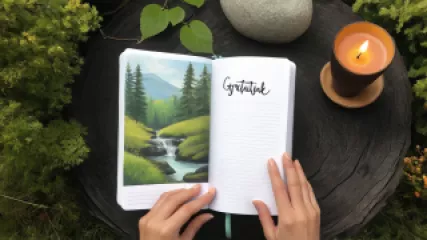Practical Gratitude Practices for Anxiety Relief
Introduction
Anxiety is a common mental health condition that can have a significant impact on a person's daily life. It often manifests as persistent worry, restlessness, and a sense of impending doom. While seeking professional help is crucial for managing anxiety, incorporating gratitude practices into therapy can be a valuable addition to the treatment plan.
Gratitude therapy, a branch of positive psychology, focuses on cultivating gratitude as a means of improving mental well-being. By expressing appreciation for the positive aspects of life, individuals can shift their focus away from anxiety-inducing thoughts and develop a more positive mindset. In this guide, we will explore practical gratitude practices that can provide anxiety relief and enhance overall mental health.
1. Gratitude Journaling
One of the most effective ways to incorporate gratitude into your daily routine is through journaling. Set aside a few minutes each day to write down things you are grateful for. It could be as simple as a beautiful sunset, a supportive friend, or a delicious meal.
Here's how you can get started with gratitude journaling:
- Choose a dedicated journal or notebook for your gratitude practice. Having a designated space can make the experience more intentional.
- Set aside a specific time each day for journaling. It could be in the morning to start your day with gratitude or in the evening to reflect on the positives.
- Write down three things you are grateful for. Be specific and try to include different aspects of your life, such as relationships, nature, or personal achievements.
- Reflect on why you are grateful for each item. This helps deepen your appreciation and understanding of the positive experiences.
- Make it a habit. Consistency is key to reaping the benefits of gratitude journaling.
By regularly engaging in gratitude journaling, you can train your mind to focus on the positive aspects of life, reducing anxiety and increasing overall well-being.
2. Gratitude Letters
Expressing gratitude directly to others can have a profound impact on both the giver and the receiver. Writing gratitude letters allows you to acknowledge and appreciate the people who have positively influenced your life.
Follow these steps to write a heartfelt gratitude letter:
- Select someone you feel grateful for. It could be a family member, friend, mentor, or even a stranger who made a difference in your life.
- Find a quiet and comfortable space where you can focus on your thoughts and emotions.
- Begin by expressing your appreciation and explaining why you are grateful for their presence in your life.
- Share specific examples of how their actions or words have impacted you positively.
- End the letter with a sincere thank you and consider sharing your hopes for the future of your relationship.
- If you feel comfortable, you can choose to personally deliver the letter or send it digitally.
Writing gratitude letters can foster feelings of connection and strengthen relationships, ultimately reducing anxiety and promoting emotional well-being.
3. Gratitude Meditation
Meditation is a powerful tool for calming the mind and reducing anxiety. By combining meditation with gratitude, you can cultivate a sense of appreciation and tranquility.
Here's a simple gratitude meditation practice to incorporate into your daily routine:
- Find a quiet and comfortable space where you can sit or lie down without distractions.
- Close your eyes and take a few deep breaths to center yourself.
- Bring to mind something you are grateful for. It could be a person, a place, or a positive experience.
- Focus on the feelings of gratitude that arise as you visualize the object of your appreciation.
- Allow these feelings to fill your entire being, soaking up the positive emotions.
- Stay in this state of gratitude for a few minutes, savoring the feelings and sensations.
- When you are ready, gently open your eyes and carry the sense of gratitude with you throughout the day.
Regular practice of gratitude meditation can help rewire your brain to focus on positive experiences, reducing anxiety and promoting a greater sense of calm and contentment.
4. Acts of Kindness
Performing acts of kindness not only benefits others but also boosts your own well-being. Engaging in altruistic behaviors can generate a sense of purpose, increase positive emotions, and reduce anxiety.
Here are some ideas for incorporating acts of kindness into your daily life:
- Offer a helping hand to a neighbor or friend in need.
- Volunteer your time at a local charity or community organization.
- Send a thoughtful message or surprise gift to someone you care about.
- Practice random acts of kindness, such as paying for someone's coffee or holding the door open for a stranger.
- Express gratitude to service workers, such as waitstaff, janitors, or delivery drivers.
By actively seeking opportunities to spread kindness, you not only contribute to the well-being of others but also experience the positive effects of gratitude and generosity.
5. Gratitude in Therapy
If you are currently receiving therapy for anxiety, discussing and incorporating gratitude practices with your therapist can be highly beneficial. Therapists trained in positive psychology and gratitude therapy can guide you through exercises specifically tailored to your needs.
Some potential gratitude-focused therapy activities may include:
- Creating a gratitude jar where you write down moments of gratitude during therapy sessions.
- Engaging in guided imagery exercises that evoke feelings of appreciation and thankfulness.
- Exploring gratitude-focused guided journaling prompts provided by your therapist.
- Discussing and reflecting on the positive aspects of your life during therapy sessions.
By integrating gratitude practices into therapy, you can enhance the effectiveness of treatment and develop coping mechanisms to manage anxiety more effectively.
Conclusion
Incorporating gratitude practices into your daily routine can have a profound impact on anxiety relief and overall mental health. From gratitude journaling to acts of kindness, each practice offers an opportunity to shift your focus from worry to appreciation.
Remember, developing a gratitude practice takes time and consistency. Be patient with yourself as you cultivate this new mindset. With regular practice, expressing gratitude can become a powerful tool in managing anxiety and fostering emotional well-being.
Disclaimer: The information in this article is intended for informational purposes only and should not be taken as professional medical or mental health advice. Always consult with a qualified healthcare professional or therapist for personalized guidance.






